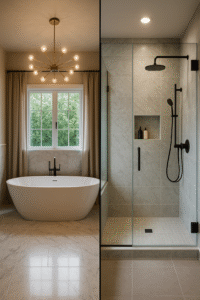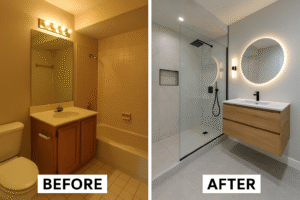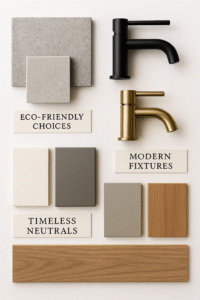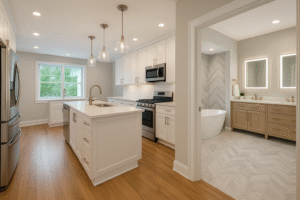Bathroom Remodeling: Tub vs. Shower — Making the Right Choice
Introduction: The Big Bathroom Remodeling Decision
Planning a bathroom remodel is one of the most exciting—and potentially overwhelming—parts of home remodeling. Whether you’re focused on a small bathroom remodel, a luxurious master bath renovation, or preparing your property for sale, deciding between a bathtub and a shower can feel like a make-or-break choice. It’s more than just picking fixtures: it’s about how you want to use your bathroom every day, how much you’re willing to spend, and what adds the most value to your property in the long run.
At DBR Construction, we’ve helped hundreds of homeowners successfully navigate their bathroom renovation journeys. We understand the stakes: your comfort, your home value, and your budget all depend on making informed decisions. The right remodel can transform a dated space into a spa-like retreat that feels both functional and beautiful. In this guide, we’ll break down:
- The pros and cons of bathtubs and showers
- Bathroom remodel cost considerations
- Common remodeling problems and how to avoid them
- Bathroom remodel ROI and long-term value
- Design trends, bathroom tiles, and modern fixtures
- Planning your bathroom remodel timeline step by step
- Bathroom remodeling contractors vs. DIY bathroom remodel options
- Financing, budgeting, and cost-saving strategies
This in-depth article will help you compare your options and feel confident in your bathroom remodel checklist, no matter the size of your project.

Why Your Tub or Shower Choice Matters
Your decision impacts every aspect of your bathroom renovation budget and the long-term performance of the space:
- Bathroom remodel cost: Bathtubs can be more expensive to install, especially if plumbing or structural changes are needed, such as reinforcing the floor for a heavy cast-iron tub or rerouting drain lines.
- Space usage: In small bathroom remodels, showers often free up valuable square footage and create a more open feel, while a tub can make the room feel cramped if space is limited.
- Bathroom remodel ROI: The right choice can increase your property value and appeal to buyers looking for modern amenities. Homebuyers often expect at least one bathtub, especially in family homes, while many downsizing buyers prioritize walk-in showers for accessibility.
- Accessibility and comfort: Showers are ideal for aging in place and for homeowners with mobility challenges, while bathtubs provide therapeutic soaking and relaxation.
According to the 2024 Cost vs. Value Report, a midrange bathroom remodel delivers up to 67% ROI, making it one of the smartest home improvement investments you can make. Investing in the right fixtures and layout now can pay off when it’s time to sell your home.
The Case for Bathtubs in a Bathroom Remodel
Benefits of Bathtubs
Bathtubs remain popular in bathroom remodel ideas for several reasons that go beyond nostalgia:
✅ Relaxation and Wellness
A soaking tub or jetted whirlpool provides a spa-like experience that showers simply can’t replicate. After a long day, there’s nothing like soaking in warm water to relieve stress, soothe sore muscles, and promote better sleep.
✅ Family-Friendly
Families with young children often prefer bathtubs for bathing little ones safely and comfortably. A bathtub makes bath time more enjoyable and less stressful for parents and kids alike.
✅ Resale Appeal
Many buyers consider at least one bathtub essential, especially families with children or those planning to start a family. This is important if you plan to sell soon, as removing all bathtubs can limit your home’s marketability.
✅ Design Versatility
Modern freestanding tubs are design centerpieces that instantly elevate your bathroom remodel ROI. They come in sculptural shapes and a variety of finishes, from minimalist matte white to sleek black or stone-look textures.
Common Problems with Bathtubs
However, tubs aren’t perfect and can create challenges in certain layouts:
❌ Space Constraints
Bathtubs occupy more floor area, making them impractical for small bathroom remodels. In narrow layouts, a tub can feel intrusive or block natural light.
❌ Water Usage
A full tub can require up to 70 gallons of water—far more than a standard shower. Over time, this can drive up utility bills and impact sustainability.
❌ Accessibility Challenges
Stepping into a tub may pose mobility issues for seniors or anyone with injuries. Even with grab bars, the high threshold can be a safety hazard compared to a curbless shower.
The Case for Showers in a Bathroom Renovation
Benefits of Showers
Showers are increasingly popular in bathroom remodeling near me searches and are a smart upgrade for modern homes:
✅ Space Efficiency
Walk-in showers save precious square footage and can make even compact bathrooms feel spacious. Glass enclosures create an open, airy look that maximizes light.
✅ Water Conservation
Showers typically use less water than baths, especially with low-flow showerheads and thermostatic controls. This not only reduces water bills but also supports an eco-friendly lifestyle.
✅ Accessibility
Zero-threshold or curbless showers with grab bars and benches support aging in place. They’re also more convenient for anyone with limited mobility or joint pain.
✅ Modern Appeal
Glass-enclosed showers with rainfall heads, body jets, and built-in niches are trending in bathroom remodel ideas. They bring a touch of luxury and elevate the everyday experience.
Common Problems with Showers
Potential drawbacks include:
❌ Resale Concerns
Eliminating all bathtubs can reduce appeal to some buyers, particularly families with small children.
❌ Moisture Issues
Poor waterproofing can lead to leaks, mold, and damage beneath bathroom tiles. Investing in quality membranes and professional installation is essential.
❌ Limited Use
Showers don’t offer the same therapeutic soaking experience, which can be a downside if you love a long soak.

Bathtub vs. Shower — Key Considerations
1. Your Bathroom Remodel Budget
Your bathroom renovation budget should guide your decision from the start. Even a basic remodel can add up quickly:
- Tub installation: $1,500–$5,000+ depending on materials, plumbing requirements, and tile work. Freestanding tubs and high-end finishes can increase costs further.
- Shower installation: $1,000–$4,000+ for standard configurations. Custom tile, frameless glass, or steam features will add to the price.
- Custom features: Body sprays, rainfall heads, heated flooring, and built-in storage niches can elevate your space but require additional budget.
Consult DBR Construction, your trusted bathroom remodeling contractors, for precise estimates and help balancing your wishlist with your budget.
2. Bathroom Remodel ROI
- Replacing an outdated tub with a sleek walk-in shower can significantly boost your bathroom remodel ROI, especially in modern homes where buyers expect contemporary finishes.
- Keeping at least one bathtub in the house protects long-term resale value and broadens your buyer pool.
- Lifestyle and Accessibility
Ask yourself:
- Do you enjoy long soaks or prefer quick showers?
- Are you remodeling for accessibility and aging in place?
- Is the bathroom primarily used by guests, children, or yourself?
- Would daily use of a shower be more practical for your household?
These questions should shape your bathroom remodel checklist and help you prioritize what truly matters.
Popular Tub and Shower Styles
Tub Styles
Explore the wide range of bathtub styles to suit your design vision and lifestyle:
- Freestanding Soaking Tub: A statement piece ideal for spacious bathrooms with a luxurious feel.
- Alcove Bathtub: Installed between three walls, practical and space-saving in smaller rooms.
- Drop-in Tub: Mounted into a framed enclosure with custom tile or stone surrounds.
- Whirlpool/Jetted Tub: Perfect for hydrotherapy and relaxation, with adjustable jets for muscle relief.
Shower Styles
Consider these popular options:
- Walk-in Shower with Frameless Glass: Clean, modern, and ideal for maximizing visual space.
- Shower-Tub Combo: Versatile for households that want the benefits of both.
- Curbless Shower for Accessibility: Seamless entry and ADA-compliant design for safety and style.
Beyond Tubs and Showers — Complete Bathroom Remodeling
A successful bathroom remodel blends fixtures, finishes, and functionality. Thoughtful details make all the difference and transform the space into a retreat you’ll love:
- Bathroom tiles: Choose durable materials like porcelain, ceramic, or natural stone in patterns that reflect your style. Subway tiles, herringbone layouts, and mosaic accents are all popular.
- Bathroom flooring: Waterproof luxury vinyl planks, large-format porcelain tiles, and even heated floors can elevate comfort and performance.
- Bathroom lighting: Layered lighting, including recessed LEDs, sconces, and statement pendants, ensures both task illumination and ambiance.
- Bathroom storage ideas: Floating vanities, recessed medicine cabinets, and built-in niches help you keep clutter under control.
- Bathroom shower remodel: Incorporate modern fixtures like rainfall showerheads, handheld sprayers, and frameless enclosures for a spa-like experience.
- Bathroom bathtub remodel: Statement tubs paired with designer faucets, integrated shelves, and custom tile surrounds create a true focal point.
How to Choose the Right Bathroom and Kitchen Fixtures
Fixtures make or break the look and function of your remodel. Choosing wisely ensures your space feels modern, efficient, and tailored to your needs, rather than generic or outdated.
Bathroom Fixtures:
- Water-efficient faucets and showerheads: These fixtures help conserve water without sacrificing performance. Look for WaterSense labels to guarantee savings on your utility bills over time.
- Touchless faucets: Great for improving hygiene and making daily routines more convenient, especially in shared or guest bathrooms. These sensors also minimize water waste when washing hands or brushing teeth.
- Matte black or brushed gold finishes: Stylish finishes like matte black create a sleek, contemporary look, while brushed gold adds a touch of warmth and luxury. Both are popular choices that elevate the aesthetic and pair beautifully with modern or transitional styles.
Kitchen Fixtures:
- Pull-down sprayer faucets: These versatile faucets make rinsing dishes, filling pots, and cleaning the sink much easier. They’re available in various finishes to coordinate with your cabinet hardware.
- Pot fillers above the stove: A pot filler reduces the need to carry heavy pots of water across the kitchen, improving convenience and reducing strain.
- Deep basin sinks: These sinks can accommodate large pots and baking sheets, making meal prep and cleanup a breeze. Stainless steel, fireclay, and granite composite are all durable options worth considering.
Eco-Friendly Remodeling — Sustainable Choices for Your Home
An eco-friendly kitchen remodel or bathroom renovation offers benefits beyond lower utility bills and can also improve your home’s resale value and appeal to environmentally conscious buyers.
Consider these sustainable upgrades:
- Low-VOC paints for cleaner air: Volatile Organic Compounds (VOCs) in traditional paint can harm indoor air quality. Low-VOC or zero-VOC paints are safer for your family and the environment.
- LED lighting to cut energy costs: LED bulbs use a fraction of the energy of incandescent bulbs and last much longer, reducing both electricity consumption and replacement costs.
- Recycled glass countertops: These countertops are not only beautiful—with a unique, speckled appearance—but also made from post-consumer materials, giving new life to recycled glass.
- WaterSense-certified fixtures: Faucets, showerheads, and toilets with this label help reduce water usage significantly while maintaining performance.
- Energy Star appliances: Appliances that meet Energy Star standards are rigorously tested for energy efficiency and can help you lower household energy consumption year after year.
Choosing sustainable products doesn’t have to mean sacrificing style—many eco-friendly options are as beautiful as they are practical.

How to Budget for a Bathroom or Kitchen Remodel
Budgeting is the foundation of a successful remodeling project. Without clear guidelines, costs can quickly spiral beyond expectations.
Best practices for effective budgeting:
- Get multiple estimates from reputable contractors: Comparing at least three quotes will give you a clear understanding of fair market pricing and help you avoid overpaying.
- Break costs into labor, materials, permits, contingencies: A transparent breakdown prevents surprises later. Labor often accounts for the largest portion, so it’s important to know exactly what you’re paying for.
- Reserve 10–15% for surprises: Even the most carefully planned remodels encounter hidden issues such as water damage, outdated wiring, or structural repairs. A contingency fund ensures you’re prepared.
- Use a kitchen remodel checklist and bathroom remodel checklist to stay organized: These checklists help you track progress, manage decisions, and keep everything on schedule.
Planning carefully now means fewer headaches later and ensures you get the most value from your investment.
Financing Options for Remodeling Projects
Financing can make your dream remodel possible without draining your savings. The right option depends on your financial situation and project size.
Consider these choices:
- Home Equity Line of Credit (HELOC): Ideal if you have substantial equity in your home. A HELOC works like a credit card, allowing you to draw funds as needed and pay interest only on what you use.
- Cash-Out Refinance: Replace your current mortgage with a larger one, using the extra funds to pay for your remodel. This often provides lower interest rates compared to personal loans.
- Personal Loans: Quick to obtain and unsecured, so you don’t need collateral. However, rates may be higher, depending on your credit.
- Credit Card Promotions: For smaller projects, 0% APR introductory offers can help you pay over time without interest if you pay off the balance before the promotional period ends.
- Contractor Payment Plans: Many remodeling companies, including DBR Construction, offer financing options to spread payments over manageable installments.
DBR Construction can help you choose the best solution for your kitchen remodel financing or bathroom remodel financing, ensuring your project stays on track financially.
Remodeling Permits and Regulations
Permits ensure compliance with safety codes, protect your investment, and prevent potential legal and insurance issues.
Common permits you may need include:
- Plumbing and electrical permits: Required whenever you relocate pipes, add circuits, or make major modifications.
- Structural permits: If you’re removing walls, moving doorways, or altering load-bearing elements.
- ADA compliance for curbless showers: Accessible bathrooms must meet specific slope and clearance requirements to comply with the Americans with Disabilities Act or local regulations.
- Inspections to protect your investment: Periodic inspections verify that work is performed safely and to code. Failing to schedule inspections can delay your project or require costly rework.
DBR Construction handles all permitting and inspections, so you can focus on design and enjoy peace of mind knowing your remodel is fully compliant.
What to Expect During Demolition and Construction
Understanding each stage helps you prepare for the temporary inconvenience of remodeling.
- Demolition: Dust control and safe disposal: Old fixtures, walls, and flooring are removed, with protective barriers installed to contain dust. Debris is promptly cleared to keep the worksite clean and safe.
- Rough-in Stage: Plumbing and wiring: New plumbing lines and electrical wiring are installed. This is also when ventilation systems are upgraded if needed.
- Installation: Cabinets, flooring, lighting: Your selected materials come to life as contractors install cabinetry, tile, lighting fixtures, and accessories.
- Finishing Touches: Paint, hardware, mirrors: Trim, grout, caulking, and paint are completed. Mirrors, towel bars, and final details are installed to complete the transformation.
DBR Construction minimizes disruption with efficient scheduling, clear communication, and a commitment to protecting your home during every phase.
Planning Your Bathroom Remodel Timeline
Most projects take 3–6 weeks, depending on scope, materials, and permitting requirements.
Typical timeline breakdown:
- Design and Permitting: 1–2 weeks: Planning layout, choosing materials, securing approvals.
- Demolition and Prep: 1 week: Removing old materials and preparing the space.
- Rough-in: 1–2 weeks: Installing plumbing, electrical, and structural framing.
- Installation: 1–2 weeks: Completing tile work, cabinetry, and fixtures.
- Final Inspections: 1 week: Ensuring all work meets code and completing the final punch list.
More complex remodels, especially those involving structural changes or custom materials, may take longer. Clear communication and a realistic timeline will keep your project on track.
DIY Bathroom Remodel vs. Hiring Contractors
DIY Bathroom Remodel Pros and Cons
Pros:
- Lower labor costs: You save money by doing the work yourself.
- Personal satisfaction: Completing the project yourself can be rewarding and give you full control over details.
Cons:
- Time-consuming: Most homeowners underestimate how long a remodel takes.
- Risk of code violations: Improper plumbing or electrical work can lead to fines or safety hazards.
- Lower bathroom remodel ROI: DIY results may not meet professional standards, potentially reducing resale value.
Benefits of Hiring DBR Construction
- Professional project management: We handle every detail, from permits to inspections.
- Warranty-backed workmanship: Your investment is protected with warranties on labor and materials.
- Code compliance: All work meets local and national building codes.
- Access to trade discounts on kitchen cabinets, bathroom tiles, and fixtures: Save on high-quality materials through our industry partnerships.

Common Bathroom Remodeling Problems—and How to Avoid Them
Avoiding common pitfalls ensures a smooth project:
- Budget Overruns: Use a detailed checklist and contingency fund to handle unexpected costs.
- Permitting Issues: Work with licensed professionals who understand local codes.
- Moisture Damage: Invest in proper waterproofing behind tiles and around fixtures.
- Delays: Build extra time into your schedule to accommodate inspections, custom orders, or unforeseen issues.
How a Bathroom Remodel Increases Home Value
A professional remodel provides significant benefits:
- Improves marketability: Updated bathrooms are a major selling point for buyers.
- Supports higher asking prices: Well-designed spaces command higher offers.
- Offers up to 67% ROI: Depending on project scope and market trends.
- Attracts modern buyers: Features like walk-in showers and energy-efficient fixtures increase appeal.
Integrating Bathroom and Kitchen Remodeling
Combining renovations can be a smart investment:
- Save time and money: Shared labor and bulk material orders reduce costs.
- Create cohesive style: Consistent finishes throughout your home enhance design flow.
- Maximize home remodeling ROI: Comprehensive updates improve both functionality and resale value.
DBR Construction also offers:
- Kitchen remodeling near me with tailored design plans
- Small kitchen remodel solutions for efficient layouts
- Kitchen countertops and kitchen lighting to refresh your space
Remodeling Mistakes to Avoid
Steer clear of these errors:
- Poor planning: Rushing into demolition without detailed plans increases costs.
- Ignoring ventilation: Inadequate airflow leads to mold and mildew.
- Choosing cheap materials: Low-quality finishes wear out quickly and reduce long-term value.
- Skipping permits: Unpermitted work can result in fines and insurance problems.
- Hiring unlicensed contractors: Always verify credentials and references to avoid liability.
Frequently Asked Questions About Bathroom and Kitchen Remodeling
Q1: How long does a bathroom remodel take?
3–6 weeks, depending on complexity.
Q2: What’s the average kitchen remodel cost?
$10,000–$50,000+.
Q3: Do I need permits?
Yes. DBR Construction handles all permits.
Q4: Can I stay home during renovation?
Usually, yes. We minimize disruption.
Q5: How can I save money?
Reface cabinets, choose midrange finishes.
Q6: What upgrades increase home value most?
Modern kitchen cabinets, bathroom lighting, and efficient appliances.
Q7: Can I combine kitchen and bathroom remodels?
Absolutely.
Q8: What’s the ROI for a kitchen remodel?
Up to 72% ROI.
Q9: Should I DIY?
Professional help is recommended for plumbing and electrical.
Q10: How do I get started?
Call DBR Construction for a free consultation.
Ready to Transform Your Home? Contact DBR Construction Today!
At DBR Construction, we make kitchen remodels, bathroom renovations, and full home remodeling stress-free and beautiful. From small kitchen remodels to luxurious spa bathrooms, our licensed professionals deliver quality craftsmanship and exceptional service every step of the way.
Call us now at +1 201 238 7307 or email dbrconstructionuf@gmail.com to schedule your free consultation.
Your dream kitchen and bathroom are just one call away!

